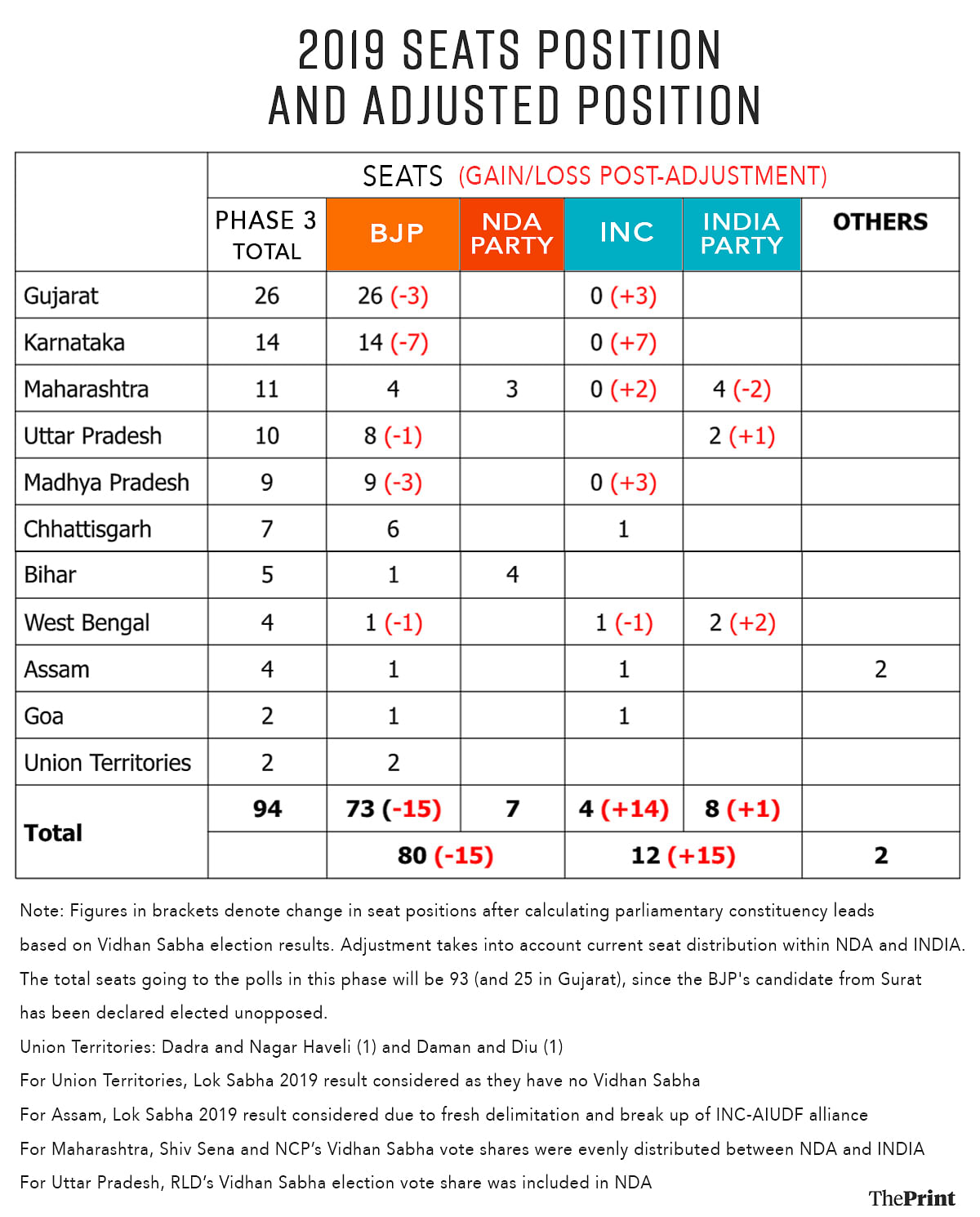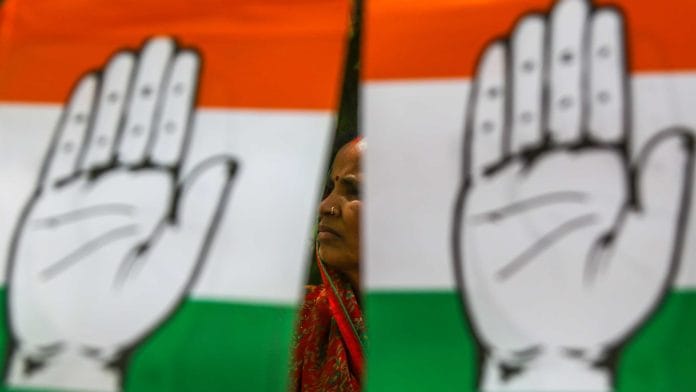The mid-point could well be the tipping point in the 2024 Lok Sabha election, where the momentum has visibly shifted against the BJP-led ruling coalition. With the conclusion of polls in 93 seats in the third phase of this seven-phase marathon, more than half of parliamentary constituencies — 283 seats to be precise — would have elected their representatives. In our assessment, the NDA may have shed about 20 of the 111 seats it won five years ago in the first two phases. The NDA can potentially lose another 20-odd seats in this third phase. Such a loss could change the overall picture and push the BJP below the majority mark in the new Lok Sabha. The BJP and its allies have to perform exceptionally well in this phase in order to retain its seemingly invincible lead.
As in the second phase, the BJP-led NDA’s problem in the third phase is that it has an awful lot of seats to defend — 80 out of the 93 seats that go to polls (94 including Surat, which the BJP has already won unopposed). It would take comfort from the fact that starting with Gujarat, the regions through which this phase travels are some of the strongest suits of the NDA – eight out of the ten states that contribute seats to this phase have an NDA government at the state-level.
The INDIA bloc, with just 12 of these seats in its kitty last time, has plenty of opportunities to make gains. It could add another 15 seats, if we go by the results of the intervening assembly elections (see accompanying table for state-wise break up). The NDA’s advantage would go down from 80:12 to 65:27. The opposition would need an additional swing of votes against the incumbent to make any further inroads.
Phase 3: 2024 Lok Sabha
BJP’s problem of plenty continues

Also read: It’s ‘Advantage INDIA bloc’ in Phase 1 of 2024 Lok Sabha election
A reversal is due in Karnataka
The BJP’s biggest challenge and INDIA’s best chance in this phase is in the Congress-ruled Karnataka. Most of the 14 seats from north and central Karnataka in this second and final phase in the state are the NDA’s to lose: in 2019, it won all 14; in 2014, it won 11; and in 2009, it won 12. The Congress had put up an impressive show last year and had led in 7 of these constituencies in the assembly elections in 2023. That by itself may not be decisive. Over the last three decades, the BJP has always upped its Lok Sabha vote share by an average of 7 percentage points over its assembly election performance in the state.
By all accounts, this historical trend is set to be reversed this time. First of all, the Siddaramaiah government has implemented its election promise of five guarantees, benefitting almost every household, especially women. This has induced a slight pro-incumbency for the Congress. Second, unlike the past when state leaders were indifferent to national elections, the Congress has ensured that all the stalwarts have skin in the game: half of the Congress candidates are close relatives of the prominent state ministers. Third, in contrast to the relative cohesion of the Congress, the BJP is a divided house. Despite the BJP entrusting the election to its canniest leader — BS Yediyurappa (and sons) — it is facing a rebellion of a former deputy chief minister, KS Eshwarappa, and disgruntlement from a prominent Lingayat seer, in a region where Lingayats – Yediyurappa’s community – are the major dominant caste.
The final and fatal blow to the NDA’s prospects has been dealt by JD(S) leader and Hassan MP Prajwal Revanna’s alleged sexual assault of scores of women over the years, which the BJP finds impossible to extricate itself from. Prime Minister Narendra Modi had campaigned for Revanna—who is seeking re-election while having fled to Germany after the assault videos were leaked—and urged the public to vote for him. The BJP’s counter-offensive, its attempt to play up the stabbing-to-death of a 23-year-old student by a Muslim former class-mate has subsided. Similarly, TV anchors in the national media may have been excited by the PM’s weird claim that the three-decade-old 4 per cent sub-quota for Muslims within OBC reservations (implemented by all governments in Karnataka, including the BJP until it scrapped this sub-quota just before the 2023 assembly election) was somehow a grand design by the Congress to transfer SC-ST-OBC quota to Muslims, but this narrative has had little resonance within Karnataka.
So, if the Congress is able to retain the vote share that it secured in the assembly election one year ago, it would wrest 7 out of the 14 seats from the BJP. The tally can go up to 11 if the Congress can absorb the vote-share of JD(S), the discredited coalition partner of the BJP.
Also read: BJP has a problem of plenty in Phase 2. It can only go down from that
INDIA chances bright in Maharashtra, MP
Just across the border from north Karnataka, some of the most prosperous as well as backward parts of Maharashtra will also be voting in the third phase. In the 2019 Lok Sabha election, out of the 11 seats voting from Maharashtra in Phase 3, the BJP and its ally, the Shiv Sena (undivided at that time), had won as many as seven dealing a huge blow to Sharad Pawar’s NCP and the Congress. In this phase, all eyes in Maharashtra will be on the western region, where Sharad Pawar has displayed uncanny skills for reinvigorating his influence in the face of this existential threat, while Ajit Pawar has been confined to micro-managing Baramati. The BJP-led NDA (Mahayuti, locally) can retain its tally if we go by the results in the assembly election held in 2019 and split evenly the votes between two factions of Shiv Sena and NCP. By all accounts, however, the NCP of Sharad Pawar and the Shiv Sena of Uddhav Thackeray is set to pick the lion’s share of the parent parties’ votes. Besides, the chemistry between Shiv Sena (UBT), NCP (Sharadchandra Pawar) and INC, wrought by the common threat of a predatory BJP, is working better than that between the BJP and NCP (Ajit Pawar), and Shiv Sena (Eknath Shinde) and NCP (Ajit Pawar). So the INDIA bloc can look forward to some gains in this phase.
In neighbouring Madhya Pradesh, INDIA’s chances appear much brighter, especially in the Chambal-Gwalior region where the Congress was not wiped out in the 2023 assembly election despite a BJP wave elsewhere in the state. The BJP won all the nine seats in 2019 but trailed behind the Congress in three of these seats in the assembly election, thus opening a window of opportunity for the opposition. What will certainly worry the BJP is the low turnout in the first two phases: there has been as much as 8.5 percentage points drop in turnout in the 26 assembly segments where the BJP won the assembly election by a margin of less than 10 percentage points.
In Uttar Pradesh, the area going to the polls consists of large parts that can be considered as traditional strongholds of the Samajwadi Party. Six of the 10 seats voting in Phase 3 belong to the Doab-Braj region, which has historically been the SP’s relatively stronger area, though it won only two seats last time. The remaining four seats fall in the Rohilkhand region that was swept by the BJP. It may not be a smooth sailing for the BJP given the strong resentment among the Kurmi community in Bareilly over eight-time MP Santosh Gangwar being denied a ticket by the party. At the same time, the presence of at least five Muslim candidates of the BSP could pose a challenge to the INDIA bloc here.
Where it gets tough for INDIA bloc
The single biggest prize in this phase is the state of Gujarat, with 25 seats up for grabs (one seat, Surat, has already been secured by the BJP). The BJP has not lost a single seat in the home state of PM Modi and Home Minister Amit Shah in the last two elections. But there are some cracks this time that suggest a close contest in a handful of seats. The Congress is reported to be back in the contest in the Adivasi-dominated seats in the eastern belt. Its alliance with the Aam Aadmi Party (AAP) seems to be helping the coalition in three more seats, where the duo had secured more votes than the BJP even in the face of a record victory of the BJP in the 2022 assembly election. The BJP’s hegemony shows signs of internal cracks with over a month-long protest by Kshatriyas and denial of seats to half the sitting MPs. All this could yield a couple of seats to the INDIA bloc.
In West Bengal, the four seats of the Muslim-dominated Malda and Murshidabad that go to the polls in this phase are witnessing a triangular contest with the Congress-Left combine being a real factor here. If we go by the assembly election results, the TMC should sweep these seats, wresting the seats held by the BJP and the Congress. However, a division of Muslim votes in this traditional Congress stronghold where the Congress-Left alliance has fielded Muslim candidates on all four seats could improve the chances for the BJP.
Similarly, the INDIA bloc faces a significant challenge in Assam, especially in Barpeta and Kokrajhar, where the Congress is competing not only against the NDA but also its own INDIA coalition partners—the CPI(M) and TMC—as also the impact of fresh delimitation.
No major upheaval should be expected in the remaining seats in the states of Bihar, Chhattisgarh, and the two seats in Goa. In Bihar, this phase will test the ability of fast-shrinking JD(U), which holds four of the five seats that go to polls in this phase, to retain its EBC (extremely backward class) votes. In Chhattisgarh, the Congress won only a single seat in 2019 and could not alter the equation in the 2023 assembly election. It would be happy to snatch another one or two seats where it is reported to be offering a stiff contest this time. In Goa, too, it would take some effort for both the blocs to change the established equation: the Hindu-dominated north Goa favours the BJP while the Christian-dense south is expected to lean toward INDIA.
All in all, if the NDA loses another 20 seats in this third phase, we are looking at something no one expected at the beginning of this election: the NDA could fall short of the magic figure of 272.
Yogendra Yadav is National Convener of the Bharat Jodo Abhiyan. He tweets @_YogendraYadav. Shreyas Sardesai is a survey researcher associated with the Bharat Jodo Abhiyan. Rahul Shastri is a researcher. Views are personal.
(Edited by Prashant)







Red Salute to Comrade Yadav
Lal Salaam to comrade Jogendra.
Why try to pass on a poorly disguised opinion piece as some sort of neutral objective analysis of ground reality?
Yogendra yadav is living in denial. As they say, “Dil ke khush rakhne ko Galib khayal achchha hai.” At least, till the results prove otherwise. But these shameless, self anointed oracles of democracy have nothing to lose even if they are proven wrong, every time.
You can sum up whole article by Gujarat prediction. Really you think congress will win 3 seat in Gujarat?? When i started to read article, I thought it is going to be a well thought and researched article but again what can you expect from person like Yogendra Yadav.